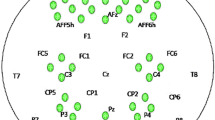Abstract
Brain-Computer Interface (BCI) is a communication system that transmits information between the brain and the outside world which does not rely on peripheral nerves and muscles. Rapid Serial Visual Presentation (RSVP)-based BCI system is an efficient and robust information retrieval method based on human vision. However, the current RSVP-BCI system requires a time-consuming calibration procedure for one new subject, which greatly restricts the use of the BCI system. In this study, we propose a zero-training method based on convolutional neural network and graph attention network with adaptive graph learning. Firstly, a single-layer convolutional neural network is used to extract EEG features. Then, the extracted features from similar samples were adaptively connected to construct the graph. Graph attention network was employed to classify the target sample through decoding the connection relationship of adjacent samples in one graph. Our proposed method achieves 86.76% mean balanced-accuracy (BA) in one self-collected dataset containing 31 subjects, which performs better than the comparison methods. This indicates our method can realize zero-calibration for an RSVP-based BCI system.
Access this chapter
Tax calculation will be finalised at checkout
Purchases are for personal use only
Similar content being viewed by others
References
Wolpaw, J.R., et al.: Brain-computer interfaces for communication and control. Clin. Neurophysiol. 113(6), pp. 767–791 (2002)
Barngrover, C., et al.: A brain-computer interface (BCI) for the detection of mine-like objects in sidescan sonar imagery. IEEE J. Ocean. Eng. 41(1), 123–138 (2015)
Acqualagna, L., Blankertz, B.: Gaze-independent BCI-spelling using rapid serial visual presentation (RSVP). Clin. Neurophysiol. 124(5), 901–908 (2013)
Lin, Z., et al.: A novel P300 BCI speller based on the triple RSVP paradigm. Sci. Rep. 8(1), 1–9 (2018)
Pohlmeyer, E.A., et al.: Closing the loop in cortically-coupled computer vision: a brain-computer interface for searching image databases. J. Neural Eng. 8(3), 036025 (2011)
Gerson, A.D., et al.: Cortically coupled computer vision for rapid image search. IEEE Trans. Neural Syst. Rehabil. Eng. 14(2), 174–179 (2006)
Marathe, A.R., et al.: Improved neural signal classification in a rapid serial visual presentation task using active learning. IEEE Trans. Neural Syst. Rehabil. Eng. 24(3), 333–343 (2015)
Barachant, A., Congedo, M.: A plug play P300 BCI using information geometry, August 2014. arXiv:1409.0107
Zanini, P., Congedo, M., Jutten, C., Said, S., Berthoumieu, Y.: Transfer learning: a Riemannian geometry framework with applications to brain-computer interfaces. IEEE Trans. Biomed. Eng. 65(5), 1107–1116 (2018). https://doi.org/10.1109/TBME.2017.2742541
Cecotti, H., Graser, A.: Convolutional neural networks for P300 detection with application to brain-computer interfaces. IEEE Trans. Pattern Anal. Mach. Intell. 33(3), 433–445 (2011). https://doi.org/10.1109/TPAMI.2010.125
Manor, R., Geva, A.B.: Convolutional neural network for multi-category rapid serial visual presentation BCI. Front. Comput. Neurosci. 9, 146 (2015)
Shan, H., Liu, Y., Stefanov, T.P.: A simple convolutional neural network for accurate P300 detection and character spelling in brain computer interface. In: IJCAI, pp. 1604–1610, July 2018
Lawhern, V.J., et al.: EEGNet: a compact convolutional neural network for EEG-based brain-computer interfaces. J. Neural Eng. 15(5), 056013 (2018)
Chollet, F.: Xception: deep learning with depthwise separable convolutions. CoRR, vol. abs/1610.02357 (2016). http://arxiv.org/abs/1610.02357
Lee, J., et al.: CNN with large data achieves true zero-training in online P300 brain-computer interface. IEEE Access 8, 74385–74400 (2020)
Naz, S., Bawane, N.: Recent trends in BCI based speller system: a survey report. Int. J. Eng. Sci. 6(7) (2016)
Velickovic, P., Cucurull, G., Casanova, A., Romero, A., Lio, P., Bengio, Y.: Graph attention networks. In: Proceedings of ICLR (2018)
Torralba, A ., et al.: The MIT-CSAIL Database of Objects and Scenes. http://web.mit.edu/torralba/www/database.html
Vaswani, A., et al.: Attention is all you need. arXiv preprint arXiv:1706.03762 (2017)
Kingma, D.P., Ba, J.: Adam: a method for stochastic optimization. arXiv preprint, arXiv:1412.6980, December 2014
Acknowledgements
This work was supported in part by Beijing Natural Science Foundation under Grant 4214078, and Grant 7222311; in part by National Natural Science Foundation of China under Grant 61906188; in part by the CAS International Collaboration Key Project under Grant 173211KYSB20190024; and in part by the Strategic Priority Research Program of CAS under Grant XDB32040200.
Author information
Authors and Affiliations
Corresponding author
Editor information
Editors and Affiliations
Rights and permissions
Copyright information
© 2022 The Author(s), under exclusive license to Springer Nature Switzerland AG
About this paper
Cite this paper
Li, X., Qiu, S., Wei, W., He, H. (2022). A Zero-Training Method for RSVP-Based Brain Computer Interface. In: Yu, S., et al. Pattern Recognition and Computer Vision. PRCV 2022. Lecture Notes in Computer Science, vol 13535. Springer, Cham. https://doi.org/10.1007/978-3-031-18910-4_10
Download citation
DOI: https://doi.org/10.1007/978-3-031-18910-4_10
Published:
Publisher Name: Springer, Cham
Print ISBN: 978-3-031-18909-8
Online ISBN: 978-3-031-18910-4
eBook Packages: Computer ScienceComputer Science (R0)




